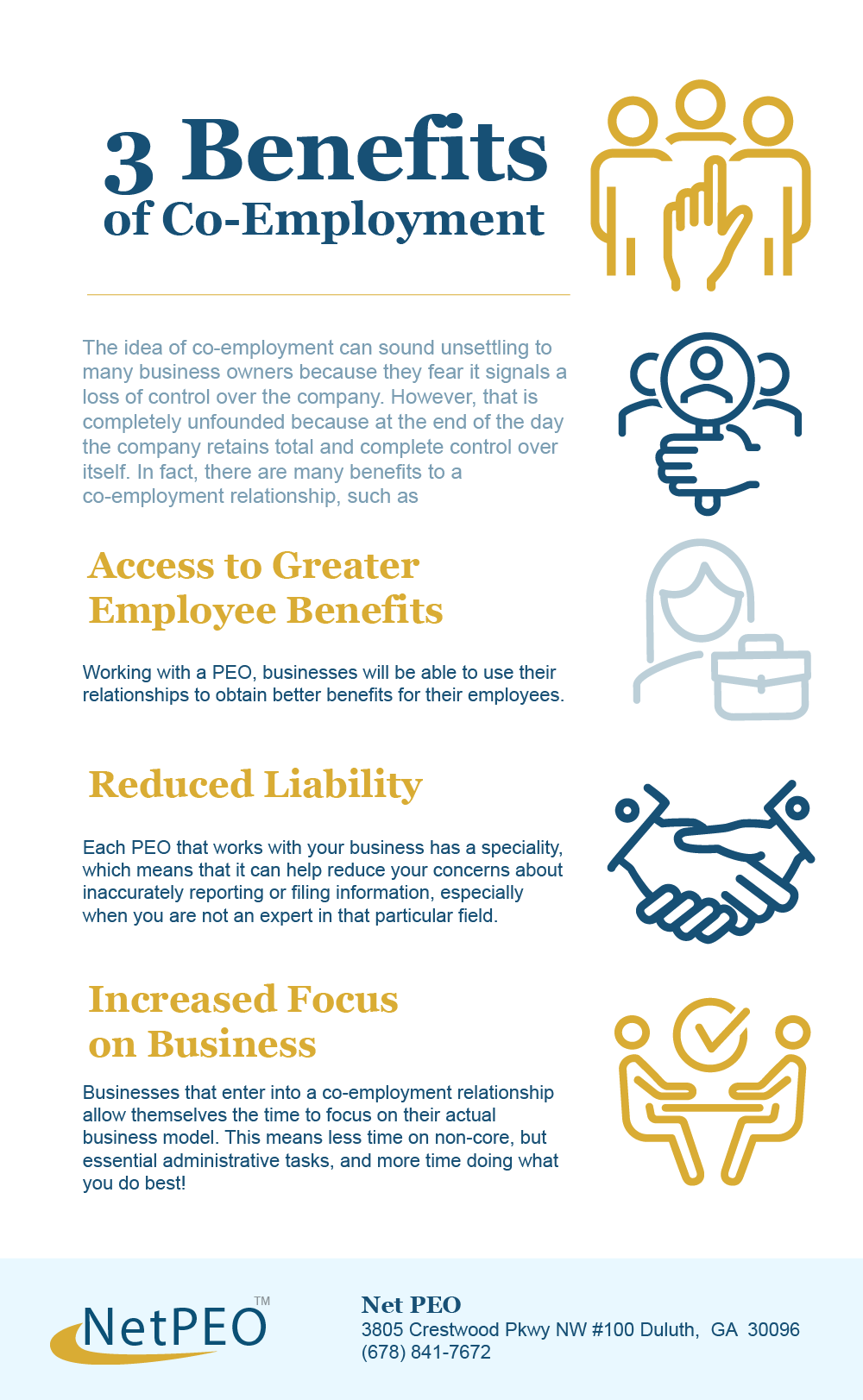Co-Employment (or Employer partnership) is a relationship that is formed by either using a staffing agency or a Professional Employer Organizations (PEOs). The term is used to express the relationship between a business, its employees and the PEO or staffing agency. With a co-employment relationship there will be two entities that share employment and legal responsibilities towards the employees of an organization.
A business may choose to outsource its administrative needs, such as its human resources department, to a PEO which will fill in that role. This then creates a Joint employment relationship between the company and the PEO over all of the employees of the business. In effect, each employee will have two employers.
The first employer is the business (often called the “worksite employer”) and the employee must follow this employer when it comes to all business related decisions. On a day to day basis, the employee will be dealing with the company employer.
The second employer is the PEO and the employee must follow the PEO when it comes to all administrative related decisions. Exactly what falls under the scope of the business and the PEO will be clearly outlined in the agreement between them. This allows the company to retain absolute control over what needs they will outsource and what they will continue to do in-house.
Joint employment is a unique arrangement where two separate entities share certain employer responsibilities for a single employee. Typically, this occurs when a business partners with a professional employer organization (PEO).
In this relationship:
-
Your business remains the primary employer: You manage day-to-day operations, employment arrangement, assign tasks, and oversee performance.
-
The PEO becomes the secondary employer: The PEO handles HR functions, payroll, benefits administration, tax compliance, and regulatory requirements.
This setup allows businesses to provide employees with health insurance, save time on hr tasks, and remain compliant with employment laws—all while retaining control over core business operations.
In short, Joint employment is a strategic partnership designed to help businesses thrive.
The Mechanics of Joint employment
To understand Joint employment fully, let’s break down how it works step by step:
Step 1: Partnering with a PEO, benefits of a professional employer organization peo
When a business signs up with a PEO, a legal agreement establishes a Joint employment relationship. This agreement specifies which responsibilities the PEO will handle and which the business retains.
Step 2: Sharing Employer Responsibilities
In a Dual employment setup, employer responsibilities are divided between the business and the PEO:
| Business Responsibilities | PEO Responsibilities |
|---|---|
| Employee supervision | Payroll processing & payroll taxes |
| Job assignments & performance management | Benefits administration & health insurance |
| Day-to-day operational decisions | HR compliance & risk management |
| Hiring & firing decisions | Employment agreement enforcement & regulatory compliance |
| Business strategy | Workers’ compensation & unemployment insurance |
This shared responsibility ensures businesses and PEOs share responsibility for employee management while keeping employment risk minimal.
Benefits of Dual employment
The idea of Joint employment can sound unsettling to many business owners because they fear it signals a loss of control over the company. However, that is completely unfounded because at the end of the day the company retains total and complete control over itself. Any authority granted to the PEO as a co-employer is limited to the exact terms of the PEO agreement. In reality, a Dual employment relationship with a PEO provides numerous benefits to everyone involved from the employees to the business owner. Some of the most common benefits of a co-employment relationship include:

- Access to greater employee benefits: businesses often struggle to provide a comprehensive benefits package, working with a PEO businesses will be able to use their relationships to obtain better benefits for their employees. A competitive benefits package can also be crucial in hiring and retaining talent for your company.
- Reduced liability: each PEO that works with your business has a speciality whether it is human resources, workers compensation claims or accounting, what this means is that you can reduce your concerns as an owner about inaccurately reporting or filing information especially when you are not an expert in that field.
- Increased focus on business: businesses that enter into a employer partnership relationship allow themselves the time to focus on their actual business model instead of drowning in non-core but essential administrative tasks such as payroll.
The benefits of a employer partnership relationship with a PEO are well worth looking into in order to regroup your business to be more efficient and focused.
Roles and Responsibilities in a Dual employment Relationship
It’s essential to understand the legal and operational roles of each party in co-employment:
Employer of Record (PEO) Responsibilities
-
Payroll and tax compliance: PEOs manage withholdings, filings, and year-end reporting.
-
Benefits administration: Employees receive health insurance, retirement plans, and other perks.
-
HR compliance: Ensures businesses follow employment laws, OSHA regulations, and employment policies.
-
Risk management: Handles workers’ compensation claims and unemployment insurance, reducing employment risk.
Business Responsibilities
-
Daily management: Supervises employees and directs their work.
-
Hiring decisions: Identifies talent that fits the company culture, whether full-time employees or independent contractors.
-
Operational control: Maintains authority over business strategy and processes, while ensuring they are not held responsible for PEO-managed compliance.
By clearly defining roles, Joint employment ensures legal compliance while allowing business owners to focus on growth. Understanding the differences between traditional employment and joint employment is essential for businesses considering a PEO, as it clarifies legal responsibilities and helps reduce employment risk.
Explaining Co-Employment to Employees
If you are about to enter into an agreement with a PEO, you should take out the time to explain the process to your staff first. Introducing new teams to your existing staff can be worrisome for them, therefore by speaking to them first you can ease some of their fears regarding Joint employment.
One of the first things you should assure your employees about is that when it comes to daily businesses issues they still need to look to their existing supervisors for guidance and instruction. It is only for specific PEO administrative issues such as benefits planning that they should go to the PEO co-employer.
Secondly, your employees may be concerned that including a PEO to your business may cause serious disturbances to their work. However, the PEOs you will work with know how to integrate into a business with a minimal amount of disturbances. It is important to remember that a PEO is only handling a small part of your company and is not involved in your core decision making.
The last issue you should be aware of is allaying concerns of employees that have works tasks that may overlap with the PEO’s. For example, if you already have a human resources administrator you will want to speak with them regarding their new relationship with a PEO. The PEO is not there to replace them but to work with them and take over tasks that may be secondary and non-essential to their job. This relationship will allow your existing employees to have greater time to focus on the parts of their work that are crucial to the company, it may even give them the freedom of time to create greater innovations for your business.
Co-employment is a business arrangement in which a staffing provider or PEO shares employer responsibilities with the client company, enabling the client company to focus on operations while the provider manages HR, payroll, and compliance.
How NetPEO Can Help Your Business
NetPEO assists businesses by helping them fill in a gap in their company reduce administrative burdens. We match companies and PEOs together so that your business has the best PEO for your specific need. Also, because of our existing and ongoing relationships with various PEOs we will negotiate on your behalf to find you not just the right PEO for you but also at a cost that is reasonable for your company. Create a Joint employment relationship with a PEO so that you can use your time to grow your business to its fullest potential.
Contact NetPEO today to find out how we can help!



